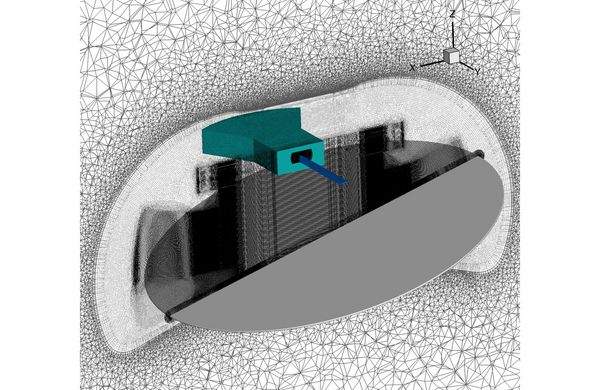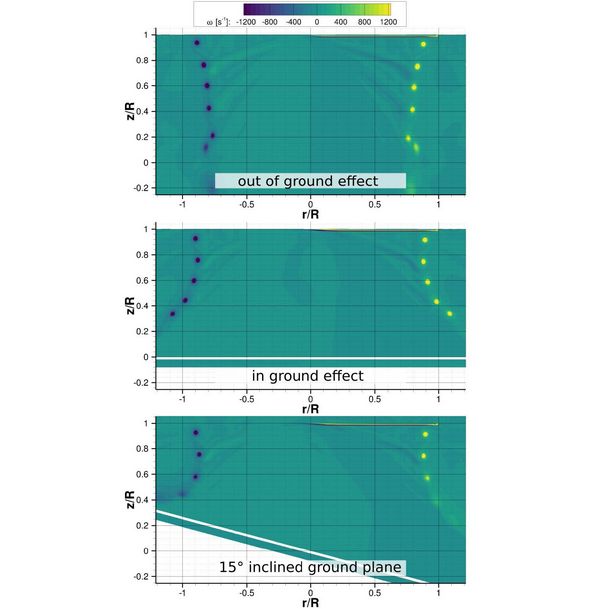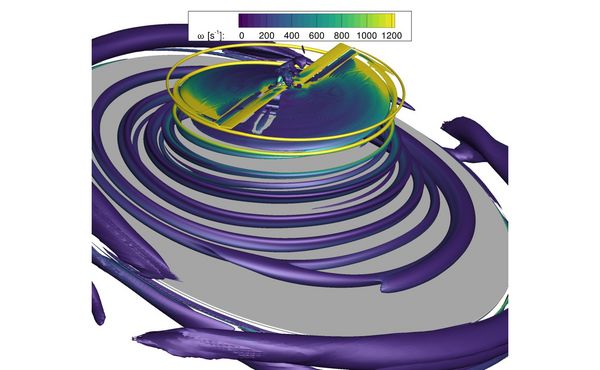ENGINEERING AND CFD
Investigation of the Flow Field and Inflow of Hovering Rotors Over Inclined Ground Planes
Principal Investigator:
Stefan Platzer
Affiliation:
Institute of Helicopter Technology, Technical University of Munich
Local Project ID:
pn56lu
HPC Platform used:
SuperMUC-NG of LRZ
Date published:
Introduction
Rotorcraft regularly hover over moving surfaces (e.g., ship decks) or inclined ground planes (e.g., hillsides and mountains). However, previous research activities on hover in ground effect mostly focused on parallel ground planes. Here, performance benefits and the associated flow topology are relatively well known. By contrast, only a very limited amount of work has been done on non-parallel ground planes and the associated changes of the complex three-dimensional flow field.
Furthermore, pilots require a significant amount of training to mitigate the risk in helicopter operations on ships or at hillsides/mountains. Hence, advanced flight control systems are desirable to increase safety and to reduce pilot workload in these situations. Moreover, engineers need to be able to accurately simulate the dynamic response of rotorcraft in such flight conditions when designing control systems for unmanned/autonomous aerial systems. Therefore there is a need for accurate, computationally efficient mathematical models capable of simulating the rotor inflow in these flow environments, because of the associated changes of the flight dynamics. Dynamic inflow-type models could fill this role.
Models have been developed in the past to account for influences of ground effect and have successfully been validated for parallel ground effect. However, the lack of experimental and high-fidelity numerical data for inclined and dynamic ground effect conditions limited the ability for validation. Moreover, a prerequisite for developing new models is an understanding of the fluid dynamics of the problem, which does not fully exist to date.
The goal of the research project at the Institute of Helicopter Technology [1] was to investigate the fluid mechanics of a hovering rotor over non-parallel ground planes (e.g., hillsides). This can be regarded as a first step towards a broader understanding of the flow field of an arbitrarily moving ground plane (e.g., a moving ship deck). Results were correlated to experimental data to evaluate the accuracy of the numerical simulations [2,3].
The simulations were performed with a model scale, two-bladed teetering rotor with a rotor radius of 0.408m, at a rotational frequency of 35Hz, which resulted in a blade tip speed of 89.7m/s. The rotor plane was located at a height of one rotor radius above the ground plane. The latter had a radius of four rotor radii.
Results and Methods
The simulations were made using the computational fluid dynamics (CFD) solver TAU, developed and maintained by the German Aerospace Center (DLR). In TAU the compressible, unsteady Reynolds-averaged Navier–Stokes equations were solved on edge based dual grids. The temporal and spatial discretization was second-order accurate.
Parallelization of the simulation was achieved by domain decomposition and the message passing concept using MPI. In general, for in ground effect simulations the tip vortex needs to be resolved for multiple rotor revolutions to accurately account for the deflection of the tip vortex trajectory caused by the presence of the ground plane. Therefore, in the course of the project grid sizes up to 184 million cells were used on up to 2,400 cores. An illustration of the grid is shown in Figure 1.

Figure 1: Sectional cut through the computational grid for in ground effect simulations with a 15° inclined ground plane. The refined grid in the tip vortex path is indicated by darker regions in the cut plane. The rotor blade is shown in blue. The chimera boundary of an additional refinement block around the blade is shown in green. © TUM
To account for turbulence effects a variety of different turbulence models was tested, ranging from a one-equation model, over (non-linear) two-equation models, to full Reynolds stress models. No turbulence model is universally applicable and no model can be used for all types of flows to reliably predict the quantities of interest. Therefore, the project also allowed to assess turbulence model performance during the large deflection of the vortex dominated flow close to the ground plane.

Figure 2: Out-of-plane vorticity contours illustrating changes of the flow field of rotors in hover in (non) parallel ground effect. The simulations were run with the Spalart-Allmaras turbulence model with rotation/curvature correction. © TUM
In addition to the large grids, multiple rotor revolutions needed to be computed to convect the starting vortex away from the rotor plane and off the ground plane. This required 18 rotor revolutions for the parallel ground plane, with a maximum of 14 hours per revolution for the full Reynolds-stress model. To be able to extract the temporal evolution of the flow field, up to 20 TB of data needed to be stored per simulation on the LRZ hosted file systems. These extensive simulations can only be performed on high performance computing systems such as SuperMUC-NG due to the required computing power, run times and storage requirements. The response of the tip vortex trajectory to (non) parallel ground effect is illustrated in Figure 2.
The overall flow field is shown in Figure 3.

Figure 3: Visualization of the tip vortex trajectory at a ground plane inclination angle of 15°, by showing a Q-criterion iso-surface (Q = 2,500 s-2) colored by vorticity magnitude. The simulation was run with the Menter SST turbulence model including the SAS modification and rotation/curvature correction. © TUM
Upon examining the flow field beneath the rotor and the inflow distribution, the simulations revealed that the behavior of the vortex dominated flow was significantly altered when inclining the ground plane. When hovering in parallel ground effect, the rotor wake was symmetric.
After inclining the ground plane, this symmetry was lost. The influence was more pronounced on the uphill side, when compared to parallel ground effect. In particular the stagnation point at the ground plane was shifted far uphill when inclining the ground plane. The inflow was mostly affected on the uphill side and at the inboard sections, whereas on the downhill side this influence was little. Moreover, the comparison to the experimental data showed good agreement of the simulations in terms of flow phenomenology, vortex trajectory, and overall vortex strength.
In general the correlation between the simulation and the experiment deteriorated for the inclined ground plane. The only exception was the full Reynolds stress model, which showed comparable performance. The rotor trim was insensitive to the chosen turbulence model, despite significant differences in the ability to preserve the tip vortices.
References and Links
[1] www.lrg.tum.de/en/ht
[2] Milluzzo, J., Martinez, A., Drayton, S. and Davids, S.: “PIV and Performance Measurements on Rotors Hovering Above Inclined Ground Planes”, American Helicopter Society 74th Annual Forum, Phoenix, AZ, 2018.
[3] Platzer, S., Milluzzo, J., Rauleder, J.: Investigation on Hovering Rotors over Inclined Ground Planes – a Computational and Experimental Study, 44th European Rotorcraft Forum, Delft, The Netherlands, 2018.
Research Team
Manfred Hajek, Stefan Platzer(PI), Jürgen Rauleder
all: Institute of Helicopter Technology, Technical University of Munich
Scientific Contact
Stefan Platzer, M.Sc.
Technische Universität München
Department of Aerospace Engineering
Boltzmannstr. 15, D-85748 Garching (Germany)
e-mail: stefan.platzer [@] tum.de
NOTE: This report was first published in the book "High Performance Computing in Science and Engineering – Garching/Munich 2020 (2021)" (ISBN 978-3-9816675-4-7)
Local project ID: pn56lu
October 2021